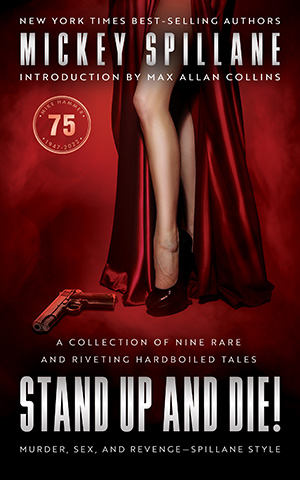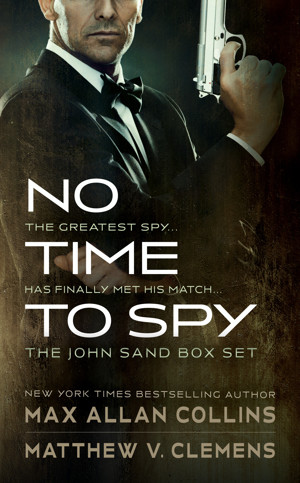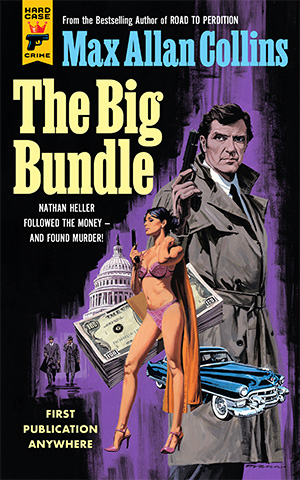The 75th anniversary of Mickey Spillane’s Mike Hammer is really kicking in. Introduced in 1947 in I, the Jury, the private eye changed the nature of tough heroes even as his creator changed the face of publishing.
Not surprisingly, I’m in thick of that celebration, with Kill Me If You Can coming out next month. The novel is based on an unproduced teleplay written by Mickey in 1954, and it’s the bridge between Kiss Me, Deadly (1952) and The Girl Hunters (1962). Velda – his secretary/partner and the love of his life – goes missing, possibly killed, and Hammer wants to know why.
The book includes five short stories completed by me from Spillane material, two of which are Hammer yarns with particular significance to the canon.
In 1952 Mickey sold the film rights to the existing Hammer novels to expatriate British producer Victor Saville. The ink was barely dry when they began to feud over Mickey’s desire for input, including casting. Saville manipulated and handled Mickey, making promises he had no intention of keeping, i.e., casting Mickey’s cop pal Jack Stang as Hammer (who wound up with a bit as a pool hall thug). For that reason Mickey came to dislike the films Saville made and, frankly, Hammer’s daddy wasn’t always fair to those films, criticizing them in public. Taking the brunt of that criticism has been the 1953 I, the Jury with Biff Elliot.
The film has also long been dismissed by some critics (including latterday noir buffs) but they – and Mickey – are wrong. It’s a wonderful though hardly perfect movie, suffering from censorship woes but still a fine translation of Spillane to the screen, really capturing the feel of the early novels. Very few films noir were shot in 3D and this one was the work of cinematographer John Alton, widely considered the finest noir director of photography of the classic period. And only a couple of noirs were made at all during that first 3D wave.
For years now, the only place you could see the 3D version of I, the Jury was at an occasional film festival (I saw it in London at the Spillane retrospective where we showed my documentary, Mike Hammer’s Mickey Spillane, 1999). And the film is a wholly different experience in 3D.
Now ClassicFlix is bringing out an elaborate Blu-ray that includes a 3D disc (for those of you who have the capacity for 3D) but also a 4K disc and a Blu-ray. Seeing it in 4K is almost like seeing it in 3D. Here’s the terrific cover.
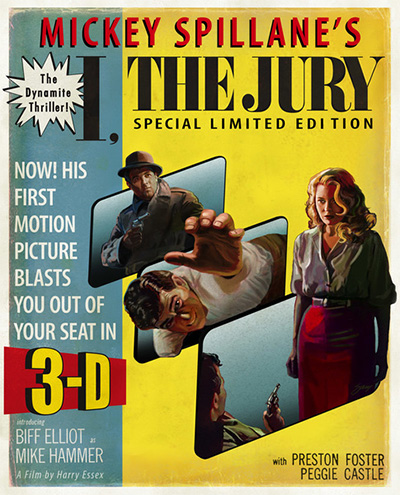
I have recorded the commentary and also have contributed a new transfer of the rare 1954 Brian Keith Mike Hammer pilot written and directed by Blake Edwards. My pal Phil Dingeldein and I created a new wraparound for the pilot that puts it into historical context.
Additionally, Phil and I are working on an expanded version of my 1999 Spillane documentary, Mike Hammer’s Mickey Spillane, bringing the story of Hammer and Spillane up to date. It will be a companion piece of sorts to the biography Jim Traylor and I have written (years in the making!), Spillane – King of Pulp Fiction, which comes out in January from Mysterious Press, and includes a lot of rare pictures as well as personal memories of mine set off in Spillane-appropriate italics.
We already have a distributor interested in doing both a Blu-ray of the documentary and getting it out to the streaming services.
As I’ve mentioned here I am also co-directing (with local theater maven Karen Cooney) a one-night presentation of the radio-style play, Encore for Murder, starring Gary Sandy (of WKRP In Cincinnati fame) as Mike Hammer. The production, an otherwise amateur one but with a strong local cast, is a benefit for the Muscatine (Iowa) Art Center.
Gary and I presented Encore for Murder in Owensboro, Kentucky in 2010 as part of the International Mystery Writers Festival, and in 2018 in Clearwater, Florida, at Ruth Eckerd Hall Theatre. We may be doing a half-hour documentary about this latest production as part of (or perhaps a Blu-ray bonus feature for) the expanded Mike Hammer’s Mickey Spillane documentary.

Crusin’ played its final gig of its season at the Art Center’s annual Ice Cream Social. The crowd was large and appreciative on a lovely day. We were very lucky this year as all five of our gigs were outdoors and nary a raindrop in sight.
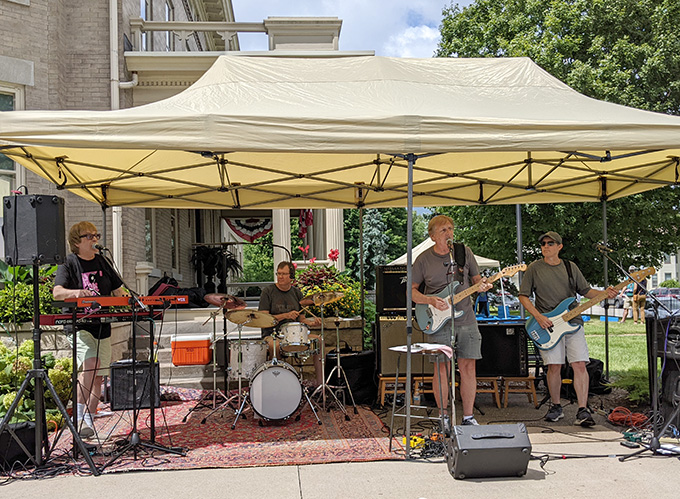
The question is, was that the last Crusin’ gig ever?
It’s the old Godfather 3 thing – “Just when I thought I was out, they pull me back in!” With one notable exception, these were all excellent gigs, very well-received, and the last several showed this version of the band at its best.
That notable exception was a private party that came up out of nowhere, which we took because nobody could think of a reason not to. I was of course unaware that I had gone back into Afib and was sick as a dog all night, wishing I were anywhere else. But playing in a band is always that way – you have a miserable experience, and want to bail from the whole damn thing; then you have a fun, great night and amnesia about the bad gig sets in.
I continue to have an ambition to do one last original material CD. We began working on one the year before the pandemic began and rehearsals shut down. And these last two summers we’ve just had enough on our plates to get prepped to make our limited schedule of appearances in the summer.
On top of that – after an unexpectedly rough week following the cardioversion procedure designed to get me out of Afib (the three previous times had taken only a day from which to recover) – I am now feeling fine. Like Nixon, tanned, rested and ready.
So I find myself considering an encore for Crusin’. It’s hard to let go of something you’ve done since (choke) 1965.
Here’s an interesting review of Batman – Second Chances, which collects much of my Batman work.
I haven’t seen it yet, but here’s a magazine you can pre-order with a new Collins/Beatty Ms. Tree interview.
I’m quoted in this terrific look by the great J. Kingston Pierce (of Rap Sheet fame) at half-hour detective TV shows of the 1950s.
Finally, here’s an interesting review of Quarry’s Blood by a reader familiar with the first few novels colliding with the much older Quarry of this one. I have a response in the comments.
M.A.C.


